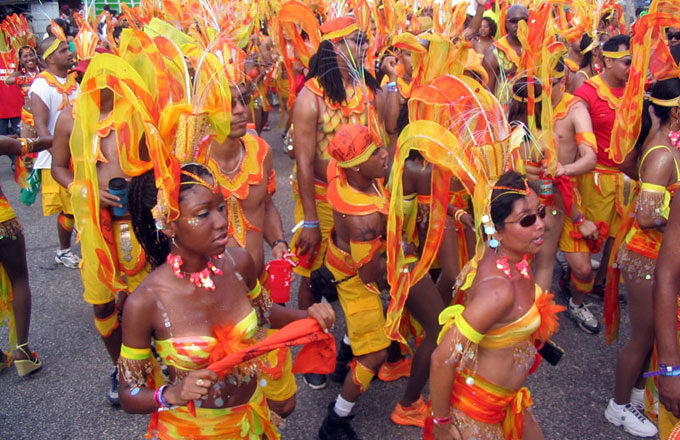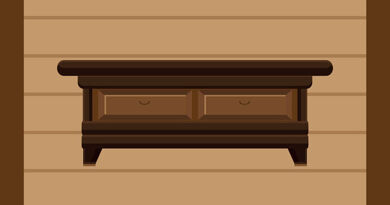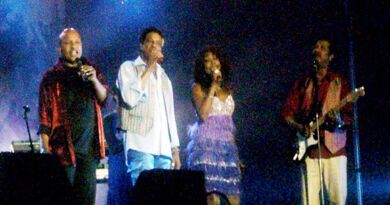Carnival in Saint Pierre
In 1888, The carnival lasted two and a half months. For two and a half months, Saint-Pierre was going to have a fever, and, in its streets, resounding tunes would be heard every Sunday, fashionable songs.
Since the closed Advent, establishments of public balls opened doors and windows and proudly displayed their flags and their names of war. Entrepreneurs fought over the names of famous musicians. At the front of the stores lined up all the paraphernalia used to hide or disguise the features: cardboard masks, with a grimacing, smiling or hideous face, metal wire masks with blue or black eyes, fixed or movable jaw , satin wolves, iced cotton wolves, false noses, false mustaches, false beards … shoemakers were overwhelmed by orders of button boots or embroidered slippers.
THE BALL OF THE THEATER OF SAINT-PIERRE MARDI GRAS FEBRUARY 4, 1888 LARGE BALL READY, MASKED, TRAVESTI
Ancient port, ô Saint-Pierre, active capital. Exotic flower, at the foot of Mont-Pelé, among The enchantment of tropical nature, You lie in silence, forever asleep! Melodious city where the cicada sang, The dazzling carnival, dead along your waves, Will no longer ring its quick bells! Dominoes and stones, which crisscrossed your streets, – Crowds, with lascL songs, forever gone – Have a mask today that they will not leave! ..
VICTOR DUQUESNAY
The carnival at Saint-Pierre is not a convention party like in the rest of the colony. Celebrating carnival is not a duty that we fulfill. Carnival is part of the life of the Saint-Pierroise population. This overflowing gaiety, this intense life, this continual movement, requires an era to burst out, to spend the excess of its activity and its gaiety, and this era is that of carnival
First, the carnival spread through the streets, long theories of negellas dressed in blue and women in skirts of rich fabrics, studded with jewelry; they paraded, each with a sugar cane and a wooden cutlass in their hand, under the command of a commander: it was the time of slavery and the people mocked their old chores; they were then princes in satin and velvet, pink dominoes, blue dominoes, black dominoes, floured stones, multicolored harlequins, open-faced puffers, hunchbacks behind, hospital doctors in large white aprons, bats with extended wings, madness with loud bells, Hurard babies in tulle dresses: it was the carnival of the opulent bourgeoisie, running the street, covered in satin. Then the real carnival, the people’s carnival.
Too poor to afford a disguise, the people make it up. A dip in molasses and there it is disguised as a big syrup negro. An old black dress in rags, a bag pierced with three holes, one for the head, two for the arms, these are still disguises and for masks, a knitted sleeve with four holes, two for seeing, one for breathing and one to speak … The people are not difficult.
And the bourgeoisie, frightened of this popular invasion, of this transformation of the carnival, begins to perch on the backs of horses, to strut around in cars, unrolling in the middle of the crowd of foot masks, the crowd of their masks to horse and carriage.
There were in fact two carnivals in Saint-Pierre, that of the Whites (corso type, with parades of floats, on which colored extras could intervene – employees of housing for the chariot of colonial work for example-) and that of Nègres, the improvised popular parade, in hastily tinkered costumes.
Carnival remained dormant during the five years of war; officially, it has not been deleted; police measures, in fact, prohibited it like most popular demonstrations. Carnival, struck by ostracism, was held with a great reserve for political reasons one feared that it is engaged in satires against the mode and that the exits of these masks are not used as pretext for disturbances.
A note to make however, is that the street carnival in Martinique no longer has its cheerfulness of yesteryear. It is no longer as tumultuous, as lively, as lively as it once was. Local or municipal decrees were responsible for many of these disappearances, the mayors often, and for public safety and tranquility, were spoilers during the Carnival period.
Today we are somewhat in the opinion of those who think that public balls have killed the street carnival. The masks that dance Saturday, Sunday and Monday, during the night, can hardly have enough hocks during the day to jump and wander in the street.
Do you like the article ?
Please leave a review here.




